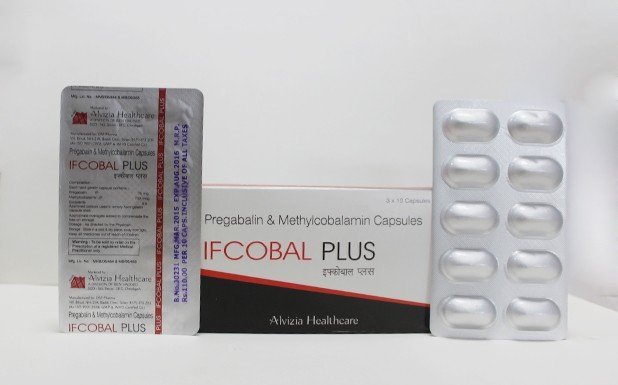
Composition
- Each Hard Gelatin Capsule Contains:
- Pregabalin
75 mg
- Methylcobalamin
750 mcg
Packing
- 5X3X10
(Alu-Alu)
MRP
- 110
Overview
What is Ifcobal-PLUS and What it is Used For?
- It is used for neuropathic pain associated with spinal cord injury.
- Diabetic peripheral neuropathy.
- Treatment of fibromyalgia.
- It is also used for treatment of chronic pain, perioperative pain, and migraine.
- Supports the nervous system.
- Helps memory and learning.
- Boosts energy.
- Helps control homocysteine levels.
- Promotes a healthy cardiovascular system.
- Enhances immune system function.
- Effectively supports brain and nerve function.
Contraindications
Pregabalin is contraindicated in patients with known hypersensitivity to pregabalin or any of its components. Vitamin B12 supplementation is generally regarded as safe during pregnancy and lactation.
Side Effects
Ifcobal-PLUS (Pregabalin and Methylcobalamin) may cause side effects:
- Dizziness
- Drowsiness
- Dry Mouth
- Constipation
Dosage
Oral:
Disclaimer:To be taken only after consulting with the doctor.
Storage
Store at room temperature, 15-30° C (59-86°F).
Keep away from moisture.
Pharmacology
Mechanism of Action
Combination of Pregabalin and Methylcobalamin not only decreases the release of neurotransmitters but also helps in regeneration of the myelin sheath. Pregabalin also has got analgesic activity which reduces the pain associated with neuropathy. Thus the combination of Pregabalin and Methylcobalamin is useful for arresting the progress of diabetic neuropathy and also helps in relieving the pain associated with neuropathy. Methylcobalamin is a co-factor of methionine synthase, an enzyme that transfers methyl groups to homocysteine to regenerate methionine. Elevated homocysteine levels are a risk factor for coronary artery disease. Methionine can be transformed to S-adenoxylmethionine (SAM) that is involved in a variety of methylation reactions in the body, one of which is alleviating depression.Pharmacodynamic Properties
It binds to the α2δ (alpha2delta) subunit of the voltage-dependent calcium channel in the central nervous system. It help to decreases the release of neurotransmitters including glutamate, norepinephrine, substance P and calcitonin gene-related peptide. However, unlike anxiolytic compounds (e.g., benzodiazepines) which exert their therapeutic effects through binding to GABA, and benzodiazepine receptors. It neither binds directly to these receptors nor augments GABA currents or affects GABA metabolism. The half life for pregabalin is 6.3 hours.Pharmacokinetic Properties
PregabalinAbsorption:Pregabalin is rapidly absorbed when administered on an empty stomach, with peak plasma concentrations occurring within one hour. Pregabalin oral bioavailability is estimated to be greater than or equal to 90% and is independent of dose. The rate of pregabalin absorption is decreased when given with food resulting in a decrease in Cmax by approximately 25 to 30% and a delay in Tmax to approximately 2.5 hours. Administration with food, however, has no clinically significant effect on the extent of absorption.
Distribution:In humans, the volume of distribution of pregabalin for an orally administered dose is approximately 0.56 L/kg and is not bound to plasma proteins.
Metabolism: Pregabalin undergoes negligible metabolism in humans. Approximately 98% of the radioactivity recovered in the urine was unchanged pregabalin. The major metabolite is N-methyl pregabalin.
Excretion:Pregabalin is eliminated from the systemic circulation primarily by renal excretion as unchanged drug. Renal clearance of pregabalin is 73 mL/minute. Methylcobalamin Mecobalamin is the neurologically active form of vitamin B12 and occurs as a water-soluble vitamin in the body. It is a cofactor in the enzyme methionine synthase, which functions to transfer methyl groups for the regeneration of methionine from homocysteine. In anaemia, it increases erythrocyte production by promoting nucleic acid synthesis in the bone marrow and by promoting maturation and division of erythrocytes.
Absorption: Peak plasma concentrations after 3 hr (oral); 0.9 hr (IM); 3 min (IV).
Excretion: Via urine.
Interactions
BEFORE TAKING THIS MEDICINE TELL THE DOCTOR ABOUT ANY MEDICAL PROBLEMS AN ALLERGIES THAT PATIENT HAS NOW OR HAS HAD.Usually drug interactions occur when it is taken with another drug or with food. Before you take a medication for a particular ailment, you should inform the health expert about intake of any other medications including non-prescription medications.